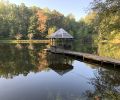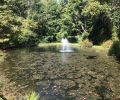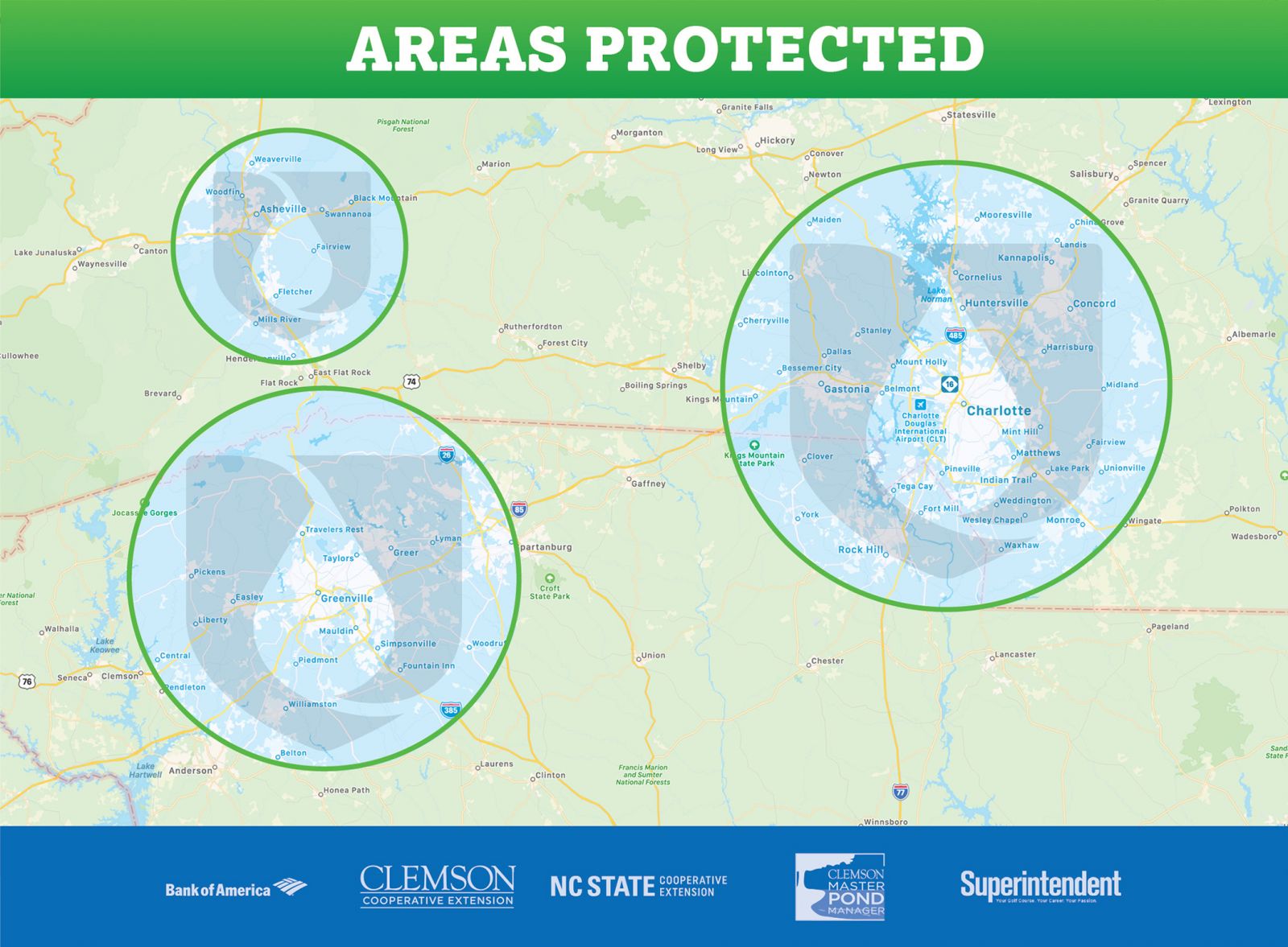Nature is probably the most efficient lake designer of all. Large, deep lakes stay naturally clean and clear for decades. However, like all biological beings, lakes age.
They fill with sediment and organic matter and eventually become meadows. In a manmade lake or pond, this progression can speed up to the point that the pond or lake is a stinking mess in just a few years.
While golf course lakes are undeniably an aesthetic asset, looks aren’t everything. Golf course lakes hold irrigation water, capture storm runoff, aid in drainage and can even be a favorite fishing hole. However, with all the responsibilities on a golf course superintendent’s priority list, lake management might be considered a necessary evil.
“Most superintendents consider ponds a nuisance or even a pain in the butt,” says Bud Laidlaw, western regional sales manager for Otterbine Barebo. Based in Phoenix, Ariz., Laidlaw has seen his share of poorly managed lakes in his long career.
“When I was 16, I worked on a golf course and when I was mowing a green close to a pond, I was instructed to just throw the grass into the pond. In the old days, we didn’t know any different,” he chuckles.
Over the past three decades, there has been untold amounts of research and innovation in the lake management business. Still, “Probably only about 30 percent of the superintendents I work with know how deep their ponds are,” Laidlaw says.
The depth of your pond is critical when selecting an aeration system. But let’s back up a bit and decide whether you need a system or not.
If you are relying solely on chemicals to control algae, you might want to reconsider. As golf courses are put under a public microscope, chemical usage and water conservation are under major scrutiny.
“In Canada, the use of chemicals to control algae is already banned,” says Richard Panten, owner of Platinum Ponds and Lake Management in Greenville, S.C. Although Panten is licensed by the state of South Carolina to spray aquatic herbicides in open waters, it’s not his first choice in techniques.
“One thing I can say about chemicals is that if you use them one year, you’ll have to keep using them the next year and the next,” says Laidlaw. “I have nothing against chemicals; they can be a great tool in a crisis situation where you have an algae bloom.
But when you spray an algae bloom, it doesn’t evaporate into the sky. It falls to the bottom of the pond and contributes to the benthic zone. It decomposes and provides nutrients for the next algae bloom.”
Benthic zone? Simply a scientific term for the bottom of the lake, where sediment and sludge build up, and organic matter decomposes. This zone can build up anywhere from one to five inches a year. That can mean a major loss of water storage capacity. A one-acre lake loses 80,000 gallons of water with every three inches of sludge and/or sediment accumulation.
There are two major factors contributing to algae blooms and a lake’s decline: nutrient loading and lack of oxygen. Chemicals cannot “cure” either.
It’s natural for the benthic layer to build up gradually. But added inputs, be it storm water, irrigation runoff, clippings, fish and bird “contributions” or fertilizer, will speed up the growth of algae and aquatic weeds, which will die, decompose and feed more algae and aquatic weeds and….well, you get the picture.
“Mother Nature has many rules,” says Cary Martin, manager at Crop Protection Services. Martin has spent years studying lake maintenance, aeration and aquatic vegetation management. “One of those is that when any kind of nutrient comes into water, it won’t just sit. It will grow something, somehow, some time.”
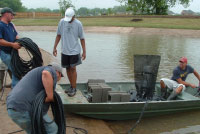 Above: Installation of an aerator fountain. Photos are courtesy Otterbine Barebo
Above: Installation of an aerator fountain. Photos are courtesy Otterbine Barebo |
“The first investment should go into nutrient management, which would actually be driving the problem,” says Dr. Rob Richardson, Assistant Professor of Crop Science at North Carolina State University in Raleigh.”You can get a solution analysis that will say exactly what the nutrient levels and pH of the water is. Anyone that wants to manage their water body should start with a solution analysis and go from there.”
Lakes also have temperature layers, which correspond to the amount of oxygen and nutrients in the water.
Algae thrives in warmer temperatures on the water’s surface and shades the water below. The warm water on top is lighter and floats on the cooler, heavier water. The problem is that the cool water is lower in oxygen. And, as with human beings, oxygen is essential to healthy pond life.
Warm surface water naturally contains lower levels of oxygen than cooler water. However, in the cooler water below, oxygen is depleted because the decomposing organic captures it.
When there is plenty of oxygen, decomposing organic matter breaks down completely through a process called “aerobic digestion.” This digestion also breaks down excess nutrients. Dissolved oxygen also supports oxidation and other biological and chemical processes that keep the water clean and clear.
Although aquatic plants and algae produce large quantities of oxygen, its movement through the lake is limited. Winds that ruffle the surface of the lake contribute to its oxygen level, as well as rainfall. But in a highly managed environment such as a golf course, that’s just not enough.
Fortunately, years of research has resulted in effective, relatively inexpensive and even beautiful ways to keep your course water features clean and clear.
There are two basic types of lake aerators: floating fountains or surface aerators. These aerators are undeniably beautiful.
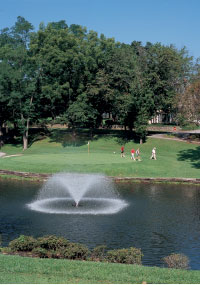 A fountain aerates a golf course pond. Photo courtesy Otterbine Barebo
A fountain aerates a golf course pond. Photo courtesy Otterbine Barebo |
“The prettier they are the less effective they are for water quality management because the pumping rates are the lowest,” Laidlaw says. “With higher pumping rates you get higher oxygen transfer rates.” For example, the typical decorative fountain with a 1 hp motor might pump 150 gallons per minute, while an industrial model will pump 920 gallons per minute and barely ruffle the surface.
“Floating fountains are about 90 percent aesthetic and 10 percent biological,” says Paten. “Bottom aeration has revolutionized the industry in the last decade. Floating fountains are in demand, but biologically bottom aerators are the ones that work.”
Also known as “diffused air,” these systems are a pipe at the bottom of the lake with holes that send air bubbles up to the surface. You may think the bubbles transfer oxygen to the water, but Martin explains otherwise.
“Actually, less than five percent of oxygen is transferred this way,” he says. “As bubbles rise, they expand. Cascading bubbles entrain cold dense water below the thermocline and lift it to the surface.” This not only allows hydrogen sulfide and carbon dioxide to escape, but it also allows the oxygen to be absorbed and circulated through the entire water column that is created.
“The long and short of it is that bottom aeration creates a chimney effect that rids the pond or lake of the thermocline, which basically keeps the lake from being healthy,” Panten says. “Fish live in the upper 20 percent of a lake’s water, and usually a floating fountain pulls water from that oxygen layer and throws it in the air and increases evaporation.
Where a bottom aeration creates an enormous amount of lift, kind of the equivalent of three or four fire hydrants all spraying at the same time.”
Surface aerators can also be energy hogs. “I have one client in a very high-end area of Greenville who has two units on a one acre pond that cost about $500 a month to run half a day,” Panten says. To make a floating fountain more effective, an adapter can draw water from the bottom of the pond, but energy costs will remain high.”
Don’t be led into thinking that diffused air is the only solution, though. “It’s 100 percent efficient at 15 feet or more,” cautions Laidlow. “The shallower the lake, the less effective it is.”
Lake science, or limnology, is a lifetime devotion for scientists. Although the basics may emphasize nutrient management and oxygen, each body of water is a complete ecosystem of its own. Don’t be afraid to ask for help. Consultants are as passionate about their work as you are about yours. Major manufacturers also have knowledgeable staff who can help you size, install and maintain aeration equipment.
“Aeration may be the best ticket to turn your pond back into the one you remember or want it to be,” concludes Martin. GCI Helen M. Stone is a freelance writer based on the West Coast and a frequent GCI contributor.
Now serving Greenville SC, Spartanburg SC, Asheville NC, Charlotte NC, Winston-Salem NC, & Greensboro NC areas.
Get started. Become a member today!


